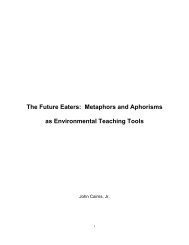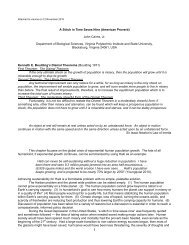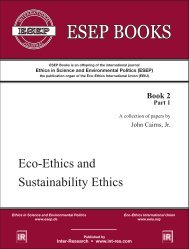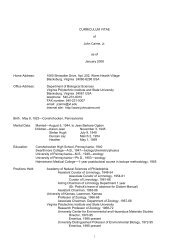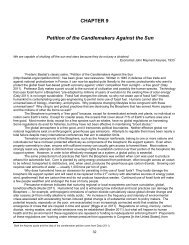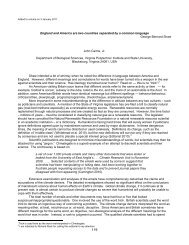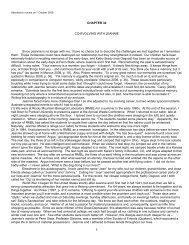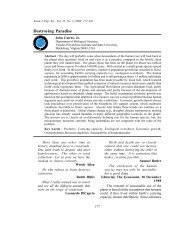View - ResearchGate
View - ResearchGate
View - ResearchGate
You also want an ePaper? Increase the reach of your titles
YUMPU automatically turns print PDFs into web optimized ePapers that Google loves.
Article 37311Everglades National Park was not dedicated until 1947. By then, the park had been reduced to onethird of the area contemplated in the original plan in order to accommodate private land holdings(Blake 1980).Even at present, ecological restoration is almost entirely in the planning stage. Of course somerestoration plans are quite a few years old. One example is the ‘Re-Watering Plan’ of the FloridaEverglades, which addressed the problem of over-drainage and even advocated that some areasbe permitted to revert to wetlands. A subsequent project involved installing a 100-mile-longperimeter levee to separate the Everglades from massive urban development. This plan eliminated160 square miles of the Everglades (Lord 1993, Light & Dineen 1994). The US Congress passed theEverglades National Park Expansion Act in 1984 in an attempt to provide a more natural distributionand timing of water delivery and in 1990 passed the Everglades Protection and EnhancementAct to enable purchase of 107600 acres of undeveloped land. The concept of sustainability wasintroduced in 1993 for the greater Everglades ecosystem. 2 Finally, Congress approved the ComprehensiveEverglades Restoration Plan in 2000 as part of the Water Resources Development Act.This brief overview of a very complicated situation is intended to illustrate how quickly an ecologicalcatastrophe can develop and how entrenched the new status quo can become. This catastropheis the basis for some important points involving both eco-ethics and environmental politics:1. Alterations of ecosystems, which ‘look good on paper,’ may quickly become persistentproblems that pose both major ethical and political problems.2. Legislative bodies (in this case the US Congress and the State of Florida legislature) maypass legislation that raises expectations but often results neither in major ecologicalrestoration nor in a widely supported political decision.3. As the complexity, duration of time, and acceptance of the damage increases, so do thedifficulties in restoring a self-regulating, naturalistic natural system. In some cases (e.g.wetlands), property rights became established, which were then difficult to expropriate.4. The longer the damage continues, the fewer original species will be available for recolonization.5. Even ecosystem restoration professionals have little experience restoring large, damagedecosystems to self-regulating systems.6. The general public and political leaders must have a strong sense of eco-ethics as well as ahigh degree of environmental literacy and commitment to the ecosystem being restored.7. The State of Florida or the US federal government, or both, have the legal authority (jurisdiction)to repair the ecological damage. Since they condoned the actions that caused theproblem, they both have an ethical responsibility to correct it.Oceanic fisheriesThe oceanic ecosystem covers 70% of Earth’s surface, but most of this system is not under thecontrol of any nation, although the UN could have the power of persuasion, if not the power of militaryforce, to ensure the ecosystem is not overexploited. World demand for seafood is well beyondthe sustainable yield. The evidence for this demand is the shrinking fishery stocks, decliningcatches, and collapsing fisheries (Brown 2001).The world fish harvest in 2000, the last year for which global data are available, was reported tobe 94.8 million tons. Some three-fourths of oceanic fisheries are fished at or beyond their sustain-2 See http://www.evergladesplan.org/about/rest_plan_02.cfm



